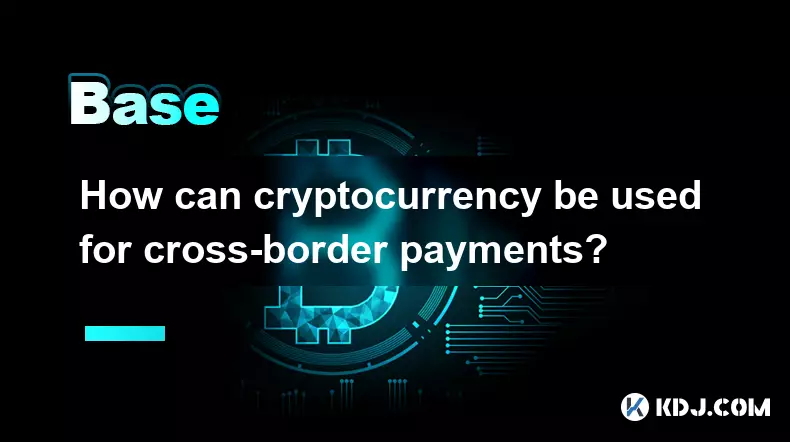-
 bitcoin
bitcoin $112195.049338 USD
2.42% -
 ethereum
ethereum $4124.915858 USD
2.81% -
 tether
tether $1.000570 USD
0.02% -
 xrp
xrp $2.861568 USD
2.25% -
 bnb
bnb $1000.346670 USD
3.04% -
 solana
solana $209.070819 USD
3.38% -
 usd-coin
usd-coin $0.999870 USD
0.02% -
 dogecoin
dogecoin $0.235379 USD
2.65% -
 tron
tron $0.335681 USD
-0.20% -
 cardano
cardano $0.803501 USD
3.38% -
 hyperliquid
hyperliquid $47.120881 USD
3.56% -
 chainlink
chainlink $21.501300 USD
3.44% -
 ethena-usde
ethena-usde $1.000571 USD
0.02% -
 avalanche
avalanche $29.793378 USD
3.62% -
 stellar
stellar $0.366964 USD
2.42%
What is a crypto bridge?
A crypto bridge enables the transfer of assets or data between different blockchains, enhancing interoperability and allowing users to move tokens across networks like Ethereum and Binance Smart Chain.
Jul 04, 2025 at 08:35 am

Understanding the Basics of a Crypto Bridge
A crypto bridge, also known as a blockchain bridge, is a mechanism that allows the transfer of assets or data between two different blockchain networks. These networks often operate on distinct protocols, consensus mechanisms, and smart contract functionalities. The primary purpose of a crypto bridge is to enable interoperability across blockchains, which are otherwise isolated ecosystems.
For instance, if you own Ethereum-based tokens (ERC-20) but want to use them on the Binance Smart Chain for lower transaction fees, a crypto bridge facilitates this process by locking your original tokens and minting equivalent tokens on the target chain.
This cross-chain functionality is essential in a decentralized environment where multiple blockchains coexist.
How Does a Crypto Bridge Work?
Crypto bridges function through a combination of smart contracts and custodial or non-custodial mechanisms. When a user initiates a cross-chain transfer, the bridge locks the original asset on the source chain and releases an equivalent amount on the destination chain. This can be done either via a wrapped token system or a native minting/burning approach.
- Lock-and-Mint Process: The original tokens are locked in a smart contract, and corresponding tokens are minted on the target blockchain.
- Burn-and-Release Process: Tokens on one chain are burned, and previously locked tokens on another chain are released back to the user.
- Custodial Bridges: Require a centralized entity to hold the original assets and issue tokens on the other side.
- Non-Custodial Bridges: Rely on algorithms and smart contracts to automate the process without intermediaries.
Each method has its pros and cons in terms of security, decentralization, and speed.
Types of Crypto Bridges
There are mainly two categories of crypto bridges: trusted bridges and trustless bridges.
- Trusted Bridges: Operate under the control of a central authority or consortium. Users must trust these entities to manage their funds securely. Examples include Binance Bridge and Wrapped Bitcoin (WBTC).
- Trustless Bridges: Function based on mathematical guarantees and code execution. No single party controls the funds. Examples include Chainlink CCIP and Hop Protocol.
Additionally, bridges can be classified as on-chain or off-chain, depending on how they validate transactions and maintain consensus between chains.
Use Cases of Blockchain Bridges
Blockchain bridges serve several practical purposes within the crypto ecosystem:
- Asset Transfer: Allows users to move tokens like ETH, BTC, or stablecoins across different blockchains such as Polygon, Arbitrum, or Avalanche.
- Decentralized Finance (DeFi): Enables liquidity providers to access DeFi protocols on various chains without being restricted to a single network.
- NFT Mobility: Facilitates the movement of NFTs between platforms built on different blockchains, enhancing market reach and accessibility.
- Layer-2 Scaling Solutions: Bridges help users interact with Layer-2 networks (e.g., Optimism, zkSync) by moving assets from Layer-1 (like Ethereum) efficiently.
These use cases demonstrate how crypto bridges enhance utility, reduce costs, and improve user experience across disparate blockchain environments.
Security Considerations and Risks
While crypto bridges offer significant benefits, they also introduce security risks due to their complex architecture and reliance on external validators or oracles.
- Smart Contract Vulnerabilities: Bugs or flaws in the bridge's code can lead to exploits, resulting in fund loss. Several high-profile hacks have targeted bridges like Wormhole and Ronin Network.
- Centralization Risks: Trusted bridges may suffer from mismanagement or collusion among validators, compromising decentralization principles.
- Oracle Manipulation: Some bridges depend on off-chain data feeds, making them susceptible to oracle manipulation or downtime.
- Reentrancy Attacks: Malicious actors may exploit reentrancy vulnerabilities in the bridge’s smart contracts to drain funds.
Users should conduct thorough research before using any bridge and consider factors like audit history, community reputation, and transparency.
Steps to Use a Crypto Bridge Safely
Using a crypto bridge involves several steps that require careful execution to avoid errors or losses.
- Choose a Reputable Bridge: Research and select a well-audited, community-trusted platform like Multichain, cBridge, or Across.
- Connect Your Wallet: Use wallets like MetaMask or Trust Wallet and ensure they support both the source and target chains.
- Select the Asset and Target Chain: Choose the token you wish to transfer and specify the destination blockchain.
- Approve the Transaction: Confirm the transaction in your wallet and pay the required gas fees on the source chain.
- Wait for Confirmation: Depending on the bridge, it may take a few minutes to hours for the assets to appear on the destination chain.
- Verify the Balance: Check your wallet on the new chain to ensure the correct amount was received.
Always double-check addresses and network settings before proceeding with any cross-chain transaction.
Frequently Asked Questions (FAQ)
Q: Can I reverse a cross-chain transfer once initiated?Once a transfer is confirmed on the source chain, it cannot be reversed unless the bridge supports a rollback mechanism, which is rare.
Q: Are all crypto bridges compatible with every blockchain?No, each bridge typically supports specific chains. You must verify whether the bridge connects your source and target blockchains.
Q: Do I need to pay fees on both chains when using a bridge?Yes, users usually pay gas fees on the source chain and sometimes additional fees on the destination chain depending on the bridge design.
Q: How do I know if a bridge is secure?Look for bridges that have undergone third-party audits, have open-source code, and maintain active community discussions or bug bounty programs.
Disclaimer:info@kdj.com
The information provided is not trading advice. kdj.com does not assume any responsibility for any investments made based on the information provided in this article. Cryptocurrencies are highly volatile and it is highly recommended that you invest with caution after thorough research!
If you believe that the content used on this website infringes your copyright, please contact us immediately (info@kdj.com) and we will delete it promptly.
- Creator Economy Revolution: Video Streaming, AI Algorithms, and the Tokenization Tsunami
- 2025-09-29 10:25:16
- Bitcoin, Ethereum, and Q4 Predictions: What's the Buzz?
- 2025-09-29 10:25:16
- Token Unlocks, DeFi, and Tokenomics: Navigating the Crypto Landscape
- 2025-09-29 10:45:13
- Crypto Bull Wipeout? Dollar Strength Steals the Show!
- 2025-09-29 10:30:01
- AlphaTON, TON, and Meme Tokens: What's the Haps?
- 2025-09-29 10:45:13
- Kanye West, YZY, and Tickets: A Wild Ride in the Crypto and Concert World
- 2025-09-29 10:30:01
Related knowledge

What are some common methods of cryptocurrency market manipulation?
Sep 27,2025 at 02:55am
Wash Trading and Its Impact on Market Perception1. Wash trading involves an individual or entity simultaneously buying and selling the same cryptocurr...

How do I read a cryptocurrency whitepaper?
Sep 27,2025 at 05:54am
Understanding the Structure of a Cryptocurrency Whitepaper1. Begin by identifying the executive summary, which outlines the project’s core vision and ...

Can I recover lost cryptocurrency?
Sep 25,2025 at 08:18am
Understanding the Nature of Cryptocurrency Loss1. Cryptocurrency operates on decentralized networks, meaning there is no central authority to reverse ...

How do I choose a cryptocurrency investment strategy?
Sep 27,2025 at 03:55pm
Understanding Risk Tolerance in Crypto Investing1. Assessing personal risk tolerance is a foundational step when entering the cryptocurrency market. V...

How can I earn passive income from cryptocurrency?
Sep 23,2025 at 10:18am
Staking Cryptocurrencies for Regular Returns1. Many blockchain networks operate on a proof-of-stake (PoS) consensus mechanism, allowing users to earn ...

How can cryptocurrency be used for cross-border payments?
Sep 28,2025 at 01:36am
Efficiency in International Transactions1. Cryptocurrency enables near-instant settlement across borders without relying on traditional banking interm...

What are some common methods of cryptocurrency market manipulation?
Sep 27,2025 at 02:55am
Wash Trading and Its Impact on Market Perception1. Wash trading involves an individual or entity simultaneously buying and selling the same cryptocurr...

How do I read a cryptocurrency whitepaper?
Sep 27,2025 at 05:54am
Understanding the Structure of a Cryptocurrency Whitepaper1. Begin by identifying the executive summary, which outlines the project’s core vision and ...

Can I recover lost cryptocurrency?
Sep 25,2025 at 08:18am
Understanding the Nature of Cryptocurrency Loss1. Cryptocurrency operates on decentralized networks, meaning there is no central authority to reverse ...

How do I choose a cryptocurrency investment strategy?
Sep 27,2025 at 03:55pm
Understanding Risk Tolerance in Crypto Investing1. Assessing personal risk tolerance is a foundational step when entering the cryptocurrency market. V...

How can I earn passive income from cryptocurrency?
Sep 23,2025 at 10:18am
Staking Cryptocurrencies for Regular Returns1. Many blockchain networks operate on a proof-of-stake (PoS) consensus mechanism, allowing users to earn ...

How can cryptocurrency be used for cross-border payments?
Sep 28,2025 at 01:36am
Efficiency in International Transactions1. Cryptocurrency enables near-instant settlement across borders without relying on traditional banking interm...
See all articles










































































